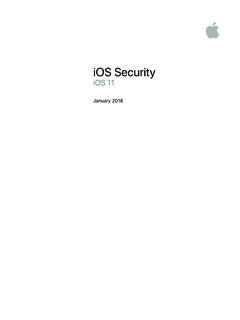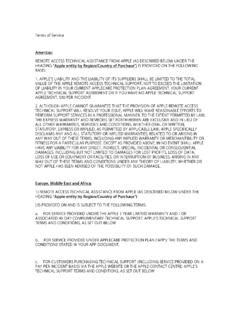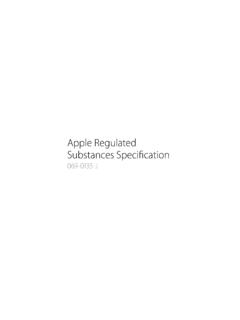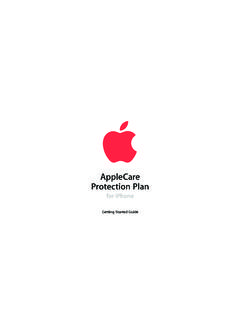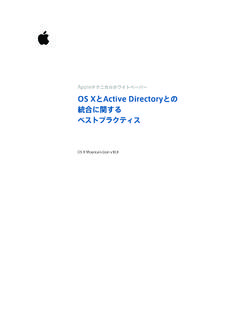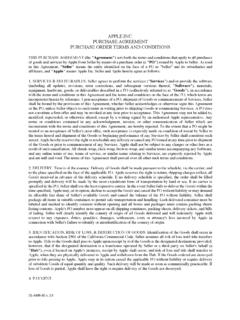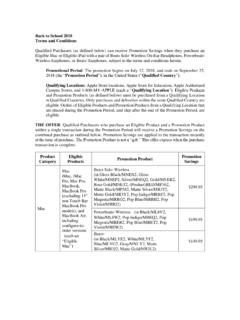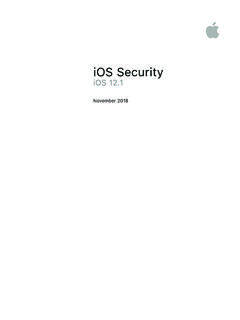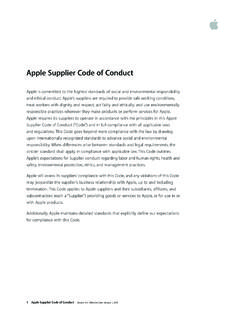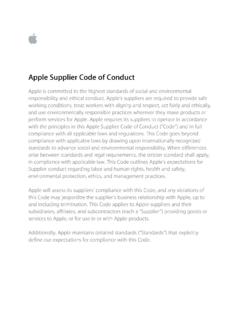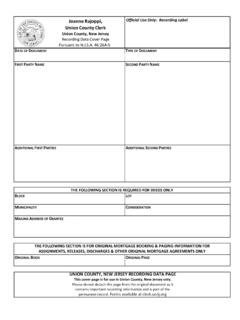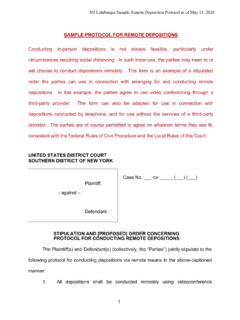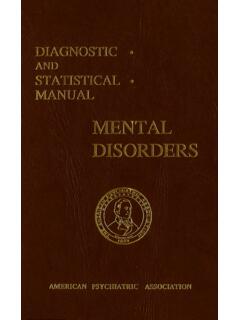Transcription of Apple Digital Masters: Music as the Artist and Sound ...
1 Apple Digital Masters: Music as the Artist and Sound Engineer Intended Whether you are a major label, an indie, an aggregator, a recording Artist , or an audio engineer, you provide the most important ingredient for Apple Music and the iTunes Store the Music itself. It is our job to faithfully and accurately deliver this Music to fans around the world exactly as you intend it to be heard. We ve designed workflows and protocols to facilitate the best possible results, ones that live up to your highest standards for audio quality. To achieve this transparency, you can use tools and technologies from Apple to ensure delivery of the highest-quality master recordings possible into our ecosystem. With more than a billion active iOS devices, Mac computers, Apple TVs and HomePods in the world, there s never been a better time to refine, codify, and communicate updated information to you about the best workflows and processes to produce the billions of files streamed and delivered daily to our mutual customers in over 100 countries around the world.
2 Note: Apple Digital Masters replaces Mastered for iTunes as the name of the program to reflect the fact that these audio advantages are available to our entire Music catalog across the Apple ecosystem, whether streamed or downloaded. All Mastered for iTunes releases are now badged as Apple Digital Masters and the Mastered for iTunes software tools are still usable for Apple Digital Masters creation. Innovation and Excellence in Sound Apple celebrates a rich history and tradition of innovation and excellence in Sound for computing as well as content creation. The original Mac was engineered fully capable of supporting audio without additional hardware or software, making it one of the first personal computers ever to ship with Sound . In fact, Apple received a GRAMMY Award for technical excellence in Music , the first and only such award ever given to a personal computing company. When iTunes launched, the decision was made to standardize on AAC instead of the more popular MP3 format simply because AAC clearly provides superior audio quality compared to other codecs at similar bit rates.
3 We worked with Dolby and Fraunhofer and have constantly iterated the Apple AAC encoder to reach the industry-leading quality it achieves today. And today Apple Music delivers lossless versions of these masters to our subscribers using the Apple Lossless Audio CODEC (ALAC.) Following the guidelines and protocols outlined in this document to create and audition AAC encodes, you can achieve simply amazing results: dynamic range that s superior to red book CD audio, and a final product that s virtually indistinguishable from the original studio recording. Technology BriefApple Digital Masters Mastering for Digital Delivery For decades, the standard for consumer Digital audio was the compact disc (CD) and most mastering was done with CDs in mind. But with billions of streams and downloads encoded as AAC to date worldwide, AAC is now the standard for Digital Music . It only makes sense to create masters specifically for this format.
4 What is AAC? AAC (Advanced Audio Coding) is a format for compressing and encoding Digital audio. AAC achieves the portability and convenience of compressed and encoded Digital audio while retaining audio quality that s indistinguishable from much larger Digital files. The iTunes catalog was initially offered in 2003 as 128 kbps AAC files, many of which were encoded from original CD masters. They sounded great in fact, these downloads led the industry in Sound quality. More than 100 million songs were sold in this format in a little over a year, changing the landscape of legal Digital Music forever. But innovation didn t stop there. We have iterated on our encoder for over fifteen years. Our AAC encoder is now able to transparently encode higher resolution audio creating files that retain the small footprint, portability, and ease of use Apple is known for. (And they Sound amazing.) High-Resolution Digital Recording Digital audio, such as that on a CD, generally uses Linear Pulse Code Modulation (LPCM often referred to simply as PCM) to represent audio signals.
5 LPCM works by taking snapshots of the analog audio signal and assigning each a numerical value. The resolution of an LPCM recording is determined by the sample rate (how many times per second samples are taken) and the bit depth (how many bits are used to represent each sample). Higher sample rates can capture higher frequencies, and higher bit depths can accurately represent a greater dynamic range. The standard for CDs is 16-bit resolution, meaning that the analog signal is sampled 44,100 times per second and each sample is given a value between -32,768 and 32,767. This resolution is often referred to as 44/16. The Nyquist sampling theorem states that to accurately represent a signal, one must use a sampling rate double that of the highest frequency being represented. The highest frequency audible to humans is around 20kHz; therefore a sampling rate of over 40kHz is required to accurately capture the audible range of frequencies.
6 Compact discs rate is adequate for this need. Even so, many experts feel that using higher sample rates during production provides better-quality audio and a superior listening experience in the end product. For this reason, higher sample rates of 48, , 96 and even 192 kHz have become standard. In addition, 24-bit recording has become the norm increasing workable headroom and total dynamic range. Challenges with Encoding Higher-Resolution Recording An inherent challenge of working with high-resolution audio has been that both the sample rate and the bit depth must be reduced to match the specifications used in mainstream distribution, whether for CD or AAC. This can be done either with software ( in the box ) or by running the mix through an additional analog stage and resampling. There are pros and cons with each technique, but both can add noise and/or distortion. Downsampling, as the word implies, is the process of using Sample Rate Conversion Technology Brief 2 Apple Digital MastersFrequency is the number of vibrations per second and is measured in Hertz (Hz).
7 Human hearing spans a range from roughly 20Hz to 20kHz. Bit rate is different than bit depth. Bit rate indicates how much data is being used per second and is calculated using the sample rate and bit depth. A 256 kbps AAC file is encoded with a target bit rate of 256 kilobits/second. It utilizes Variable Bit Rate (VBR) encoding, which uses each bit strategically, dynamically allocating less data for simple sections and more data for complex passages. Dynamic Range, when used as a general audio term, refers to the range of possible volumes the difference between the softest and the loudest parts. In Digital audio, aliasing refers to audible artifacts created when higher frequencies are sampled at an insufficient rate. The result is distortion. A visual metaphor for aliasing can be found in the wagon wheel effect a rapidly spinning wagon wheel filmed at a low frame rate can appear to be moving backward.
8 (SRC) to lower the sample rate (for example, from 96kHz to 48kHz). This process may create aliasing, an undesired effect. Dithering (or adding dither) is a technique used when reducing a file s bit depth (for example, from 24-bit to 16-bit). It is an attempt to reduce the distortion inherent in this process. Dither is a tradeoff the distortion is reduced at the cost of added noise. (Another bit depth reduction option is called truncating, where the additional bits are simply removed. This can cause quantization distortion.) Improved Conversion and Encoding for AAC Apple s latest encoding methodology is a two-step process. The first step in the encoding path is to use state-of-the-art mastering-quality Sample Rate Conversion (SRC) to resample the master file to a production sample rate. This SRC outputs a 32-bit floating-point file which can preserve values that might otherwise fall outside of the permitted amplitude range.
9 This file is saved in a CAF container. This critical intermediary step prevents any aliasing or clipping that could otherwise occur in SRC. It is this 32-bit floating file that s used as the input to the encoder this is one key reason we can achieve superior results. Our encoders then use every bit of resolution available, preserving all the dynamic range of the 24-bit source file and eliminating the need for adding dither. The advantage of this is twofold. Not only does it obviate the need of adding dither noise, it also lets the encoders work more efficiently as they don t need to waste resources encoding this unwanted and unnecessary noise. By using this highly accurate file directly from our SRC and taking advantage of its clean signal, our encoder can deliver the final product exactly as the Artist and Sound engineers intended it to Sound . Lossless Distribution In addition, Apple Music can now deliver lossless encodings to customers using the Apple Lossless Audio CODEC (ALAC.)
10 Best Practices for Apple Digital Masters Our latest high-resolution encoding process ensures that your Music is transparently and faithfully distributed in the way you intended it to be heard. However, before you submit songs to Apple for encoding, there are some best practices you can follow to ensure that your audio is optimized for Apple Music or the iTunes store. Use High-Resolution Sources To take best advantage of our latest encoders, use only 24-bit sources and send us the highest-resolution master file possible, appropriate to the medium and the project. Don t upsample files to a higher resolution than their original format. Upsampling won t recover or add information to an audio file. Similarly, don t bit-pad or recapture 16-bit files in 24-bit. Provide High-Resolution Masters Some mastering engineers prefer to control the SRC process by sending already converted files, however we ask that you deliver the highest native sample rate available.
